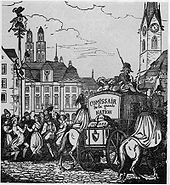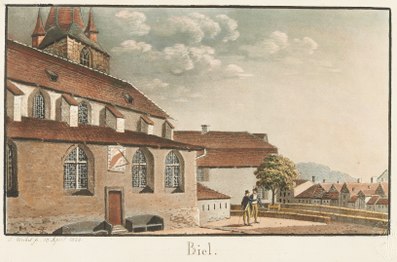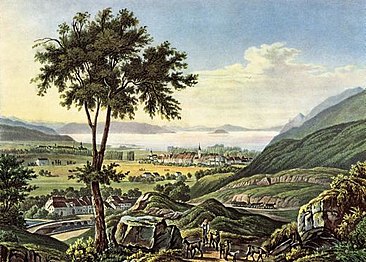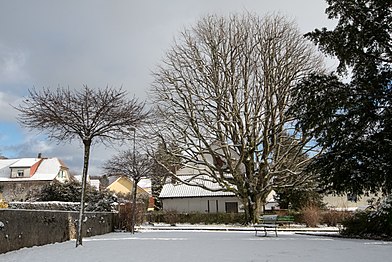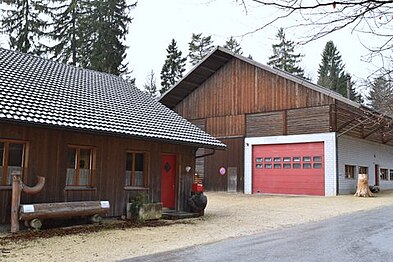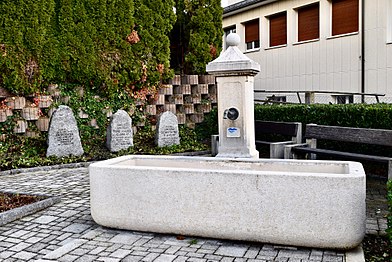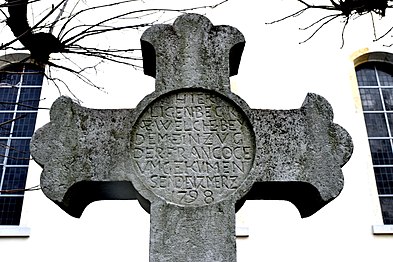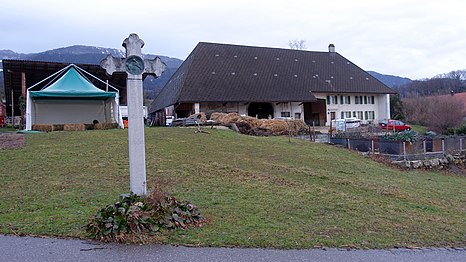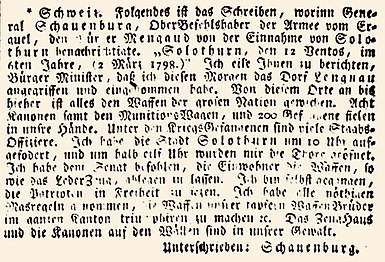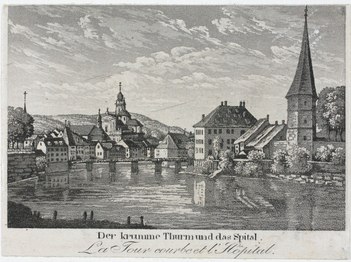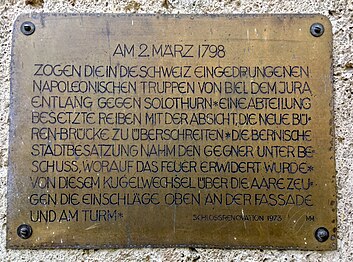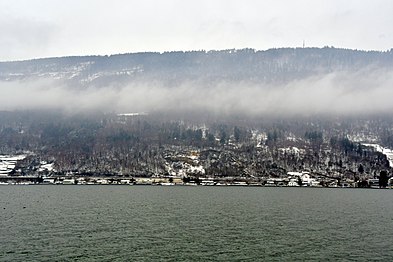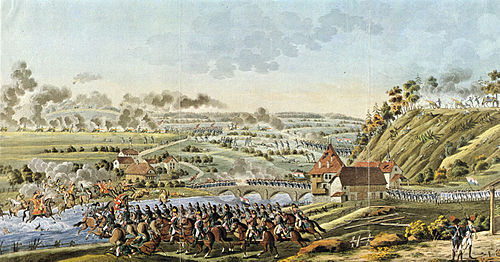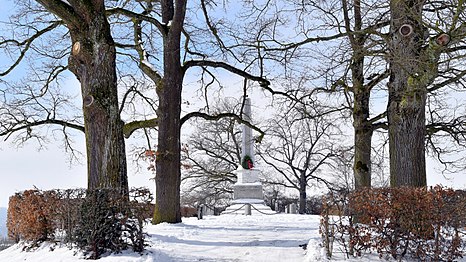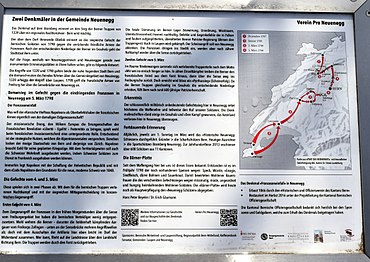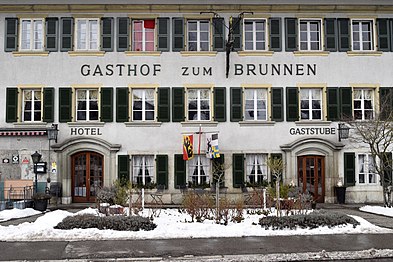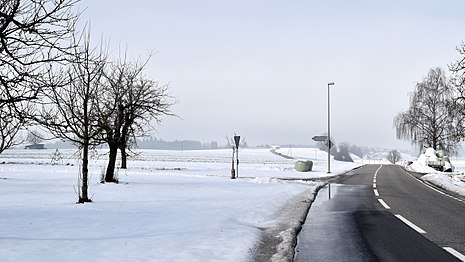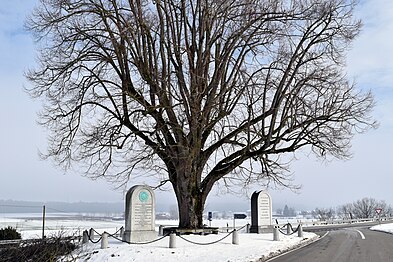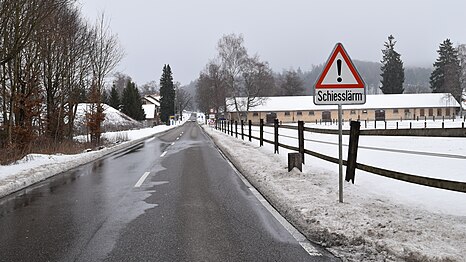French invasion (Switzerland)
Lengnau · Grenchen · Ruhsel · Büren · Col de la Croix · St. Niklaus · Fraubrunnen · Neuenegg · Grauholz · Hägglingen · Wollerau · Stucketen-Chäppeli · Schindellegi · Rothenthurm · Morgarten · Pfyn I · Nidwalden · Pfyn II
The French invasion was a military conflict between the First French Republic and the Old Confederation between January 28, 1798 and May 28, 1799. The French victory brought the military occupation of a large part of the territory of today's Switzerland by France and the establishment of the Helvetic Republic as a daughter republic with itself. The French invasion traditionally ended the era of the Ancien Régime or the Old Confederation in Swiss historiography and ushered in the Helvetic. The word creation «Franzoseneinfall» was used by the Bernese historian Richard Feller . On the French side, the event was also referred to as Campagne d'Helvétie .
prehistory
Until the fall of the French Ancien Régime, the old Confederation, as a loose alliance of sovereign cantons and their allies, was strongly oriented towards the neighboring state. Soldiers' alliances and trade agreements had existed since the Middle Ages that effectively turned the Swiss Confederation into a French protectorate. Austria was only able to maintain limited influence in the cantons of eastern and central Switzerland . The French Revolution of 1789/1799 and the termination of the pay contracts after the Tuileries storm in 1792 resulted in an alienation from France, which was fueled politically by the agitation of reactionary French emigrants in the Confederation and revolutionary-minded federal emigrants in France . Nevertheless, the Confederation was militarily neutral towards France during the First Coalition War and even tolerated the occupation and annexation of the Three Leagues and the northern part of the Principality of Basel by France in 1792. After the First Coalition War, the Austrian monarchy ceded Switzerland, with the exception of Graubünden , the sphere of influence of the First French Republic . Switzerland was now alone and the neutrality policy that had been in place since 1792 seemed no longer sufficient for France. France had different interests in Switzerland:
- Alpine passes: The occupation of the Swiss Alpine passes would make northern Italy more accessible to French troops.
- Financial resources: Some cantons had considerable financial resources that would have been very helpful to the French in their further war plans.
- The Swiss population would be a new recruiting base for soldiers.
Due to the treaties (military capitulations) with France, the Diet had the right to recall the Swiss regiments ( Reisläufer ) for defense if the Confederation was in danger. The introduction of conscription in France had made the federal professional soldiers superfluous and the Swiss regiments were dissolved. When France broke the Treaty of Perpetual Peace of 1516 and invaded Switzerland in 1798 , there were no intact regiments of professional soldiers left who could have been used for defense.
Another incursion into the Principality of Basel
After the northern part of the Principality of Basel had been annexed in 1792, the southern part was also occupied by the French at the end of 1797. The Helvetic Revolution broke out on January 17, 1798 .
Incursion in Bern, Solothurn and Freiburg
On January 24th, the Lemanic Republic was proclaimed, which immediately sent a request for help to France. On January 28, the French under General Ménard invaded Vaud, which was then part of Bern, with around 12,000 men . Some of the French invasion troops crossed Lake Geneva by ship and landed in Nyon and Lausanne . The Bernese troops were forced to retreat in view of the French superiority and gathered again in the area of Murten and Freiburg in Üechtland .
In the meantime, General von Schauenburg advanced with a second army from the former Principality of Basel from the north towards Bern. The French called on the Bern government to hand over government power to the reform or peace party. The Bernese refused, however, and the French now used this as a reason for war.
On February 2, 1798, the Bern War Council founded the Légion fidèle , which consisted of loyal volunteers from Vaud.
The French troops began to advance in a pincer movement from the direction of Vaud and the Bernese Jura towards Freiburg, Solothurn and Bern in early March. On March 1, 1798, the first battles began. On March 2, there were battles near Lengnau , Grenchen and in the Ruhsel (forest between Alfermée and Twann ). On the same day, Freiburg was conquered by the French. On March 3, 1798, the Solothurn troops capitulated . On the same day, there was a battle between Bern and French troops at Col de la Croix . General Karl Ludwig von Erlach had to vacate his position at Murten.
The Bern government was split into two camps. Schultheiss Niklaus Friedrich von Steiger took a tough stance towards France and wanted to continue the war. The Deutschseckelmeister von Frisching advocated negotiations with the French. This disagreement caused uncertainty among the Bernese troops and population. General von Erlach and fifty high-ranking officers pressed the Grand Council to approve the fighting.
After the Grand Council of Erlach gave the order to fight the French, the latter surrendered to the French troops at Büren an der Aare . During the battle, however, the order came that the Bernese troops should withdraw in order to protect the city of Bern. On March 3, 1798, the French General Brune issued an ultimatum to the Bern government and called for Bern to surrender. Thereupon the government under Mayor von Steiger abdicated on March 4th, but refused to surrender to the military. Despite the resignation of the government, the Bernese troops tried to repel the French attack.
On March 5, 1798, there was the battle of St. Niklaus , the battles of Fraubrunnen and Neuenegg and the decisive battle of the Grauholz . On the same day the French general Schauenburg received the surrender of Bern and the mayor of the city of Bern, Niklaus Friedrich von Steiger went into exile.
On March 6th the French troops advanced from the south and captured Murten and Freiburg. During the entire time, the federal auxiliary troops with about 4,000 men did not intervene in the fighting. The French raised about 35,000 men, compared to only about 20,000 Bernese. About 700 people fell on the Bern side. The French casualties are unknown.
When the French invaded the Swiss Confederation in 1798, they were targeting the state treasures of the cantons in order to free themselves from their financial predicament.
In Bern, by far the largest treasury, the Bern State Treasury, fell into their hands. The gold from the vault under the Bern City Hall was loaded onto carriages and brought to Paris together with the bears from the bear pit in a symbolic act . But the securities of the Bernese were even more valuable. The Bernese were extremely successful in managing and investing state finances and became a heavyweight in the London financial center. When the Helvetic Republic fell in 1803, the Bernese had spent more than two thirds of the investment value of their securities on their replacement. The tug of war did not end until the Congress of Vienna in 1814/15. The victorious great powers decided that the Bernese were not entitled to the income from the securities that had accrued in the meantime, but to financial compensation from France. However, this was little consolation for the Bernese, as it only covered a fraction of the loss caused by the French invasion.
"The canton of Bern receives a considerable income by lending part of the state treasure to other countries."
"If the Bernese had been able to save their state treasure through the turmoil of the revolution and continued to invest it on the capital market with a similar, more conservative investment strategy as during the 18th century, it would have amounted to around CHF 623 billion today."
After the war, the Bernese Gottlieb von Jenner managed to bring parts of the Bern state treasury back to Bern by bribery.
Resistance in Schwyz, Nidwalden, Uri, Zug and Glarus
The cantons of Schwyz , Nidwalden , Uri , Glarus and Zug rejected the constitution of the Helvetic Republic in April 1798 and began to raise an army of around 10,000 men under the command of Alois von Reding . On April 21, von Reding launched the offensive. The strategic goal of Aarau, the seat of the Helvetic government, was to be achieved in three axes. On April 22nd, the left wing advanced to Obwalden , occupied the Brünig Pass and reached the Bernese Oberland in Meiringen . The troops of the right wing under the Glarus Colonel Paravicini conquered Rapperswil , but remained in position waiting. The Zug troops under Captain Andermatt advanced into Freiamt . After a battle with a French vanguard ( battle near Hägglingen ) they had to withdraw to Muri on April 26th . Von Reding himself advanced against Lucerne with a force of around 4,000 soldiers and captured the city on April 29, 1798.
The hoped-for elevation of the conquered areas largely failed to materialize. Obwalden was forced to reject the Helvetic Constitution as well. However, there was no mass survey of the rural population of the Bernese Oberland or the Lucerne countryside. After a few days the offensive stalled. On the evening of April 29, when it became known that Zug had surrendered without a fight, Reding's troops withdrew from Lucerne and returned to the Schwyz area to defend at least the home country. The offensive had become a defensive.
The French general Schauenburg triggered the counterattack with around 12,000 men. In two wings he tried to advance to Schwyz with the strategic goal of Einsiedeln . The left wing under General Nouvion advanced on both sides of Lake Zurich. In Richterswil the French attack was stopped twice. However, Rapperswil was soon abandoned by Colonel Paravicini and he returned with his troops to Glarus. The Schwyz troops withdrew undefeated to Schindellegi and Etzel . The right wing, under General Jordi, advanced towards Zug and Lucerne without encountering resistance. The advance to Küssnacht initially failed. A small force of about 400 men was able to stop the French army at Immensee .
After the French had conquered Rapperswil, there was a battle at Wollerau on April 30, 1798 . After the defeat, Glarus capitulated . On May 1st, Küssnacht fell into the hands of the French and the Schwyz were now alone against the French attacking from the north and west. On May 2nd there was a battle at Schindellegi and on the same day there was a battle at Rothenthurm and the battle at Morgarten . On May 4th, the Schwyzer Landsgemeinde capitulated . However, because of their will to resist, the French granted the Central Switzerland mild conditions of surrender and refrained from disarming the population.
Valais
At the beginning of May 1798, the Upper Valais rose against the French and were defeated on May 17, 1798 in the 1st Pfynschlacht . At the beginning of May 1799 the Upper Valais rose again under the command of the Visp Count Ferdinand Venetz and were defeated again by the French in the 2nd Pfynschlacht . After the battle the French plundered Visp and burned the town down.
Nidwalden
On August 29, 1798, the Nidwalden rose again and between September 7 and 9 the horror days of Nidwalden took place .
Grisons
In the spring of 1799 the population of the Free State of the Three Leagues rose against the French occupation. During the fighting between Chur , Ems and Bonaduz , well over 600 soldiers and a large number of French soldiers were killed. In November 2007, a mass grave in a forgotten lime kiln from that time was discovered by chance on the Ems-Chemie site .
consequences
On August 19, 1798, the Helvetic Republic signed a defensive and offensive alliance with France. Thus the complete defeat and downfall of the old Confederation was sealed. The French invasion brought devastation and looting over entire areas, for example the Einsiedeln monastery was looted. The French forced the community and private individuals to billet and feed their troops. This led to strong anti-French and anti-republican reflexes in the population.
The French forced Switzerland to take out compulsory loans and make contributions. Together with the stolen state treasures of the cities of Bern and Zurich, around 30 million livres were collected, which, according to French historians , served Napoleon to finance the Egypt campaign .
Commemoration
In Bern and central Switzerland, the memory of the resistance against the French has been preserved to this day:
- 1805 burial of the former Bernese schoolboy Niklaus Friedrich von Steiger
- In 1821 a name plaque of the fallen was unveiled in the Bern Minster
- In 1872 August Weckesser painted the picture Reding's Farewell
- The Grauholzdenkmal is inaugurated in 1886
- Up until the beginning of the 20th century, processions took place every year on the site of a mass grave in Ems. After the rediscovery in 2007, a memorial plaque commemorates the fallen.
- In literary terms, Franz Niklaus König and Jeremias Gotthelf have erected a memorial to the Bernese Landsturm and the combative women ( Elsi, the strange maid )
- In popular memory, the idea of having been betrayed by the Bernese authorities ( e.g. Fraubrunnenlied ) remained
Photo series on the events in the cantons of Bern and Solothurn
The following series of images illustrates selected events from the French invasion of Lengnau on March 2, 1798 at 4 o'clock to the fall of Bern on March 5, 1798. This takes the form of “silent witnesses”. These can be: paintings, buildings, places, landscapes, monuments, borders and newspaper reports.
The French march in front of and near Lengnau
«From the Christian month of 1797 until the end of Hornung in 1798, the iron chain of the French outposts, standing around Lengnau on episcopal lands, closed ring after ring. Covered by them, General Schauenburg had already completed his deployment on the 16th of Hornung and stood with the bulk of his armed forces in crowded accommodation on the Büttenberg and the neighboring villages, at the southern foot of the Jura, in Pieterlen, on the Jura in Rothmund, in farmsteads and field camps . Most of his artillery, approx. 18 batteries, on the Büttenberg, beyond the frozen marshes of the Lengnauermoos and the Aegleren, directly opposite Lengnau. With part of the artillery astride the Pieterlen-Lengnau road near the Farb. "
Napoleon Bonaparte. The motives for occupying Switzerland were (a) the Alpine passes, (b) the wealth of Switzerland and (c) the recruitment potential of young, able-bodied men. The plan of attack will probably have received its definitive contours during its passage via Geneva, Bern, Solothurn and Basel in November 1797
Explanations
Combat operations on March 2, 1798
First battle in Lengnau
«At 4 o'clock in the morning the French broke into the village from three sides with superior strength. The Oberlanders jumped up and hurried to their posts. The four guns poured their bullets. The officers set the example. The battle raged stubbornly in the dark, which was illuminated by blazing ridges. Women fought with; their two fell. But the Bernese, unaccustomed to night fighting and not able to cope with the constant inflation, could not hold out against the overwhelming odds. ... The Bernese lost 200 dead and wounded and just as many prisoners ... »
Lengnau church with rectory around 1824

Explanations
Resistance at Grenchen
«And now the enemy was advancing towards Grenchen. ... With a little effort the main French power seized the entrenchments west of the village, as well as the two cannons. On the other hand, the enemy division approaching from Allerheiligen met stubborn resistance above the village near the tuff pits. ... But now a French column appeared that had pushed over the mountain and threatened to take the defenders in the back. Therefore they withdrew into the village, where they recently fought back until the enemy penetrated the village from all sides, made any further resistance impossible by their superior strength and forced the regular troops to retreat against Bettlach and Haag. "
Explanations
Resistance at Haag Bach
“The May Battalion from the Zofingen Regiment received the fugitives near Haag and opposed the pursuers in the poorly fortified village. But after a short battle it was bypassed and most of the fugitives were caught. "
Haag Bach, in 1375 the village was spared the Gugler invasion, the chapel built in 1379 commemorates this

Explanations
Battle at the Bellacher and Selzacher ponds
“At the so-called Bellacher and Selzacher ponds, to the south and north between hills covered with bushes and forests, above the old country road and separated by a narrow wooden path, the Bernese once again resisted vigorously. There was no lack of examples of great heroism and self-sacrifice. Many a man from Solothurn and Bern defended themselves like a madman and, to the point of death, disdaining every shout of pardon. ... But the French superiority was too great and from now on all resistance had ceased ... »
Explanations
Surrender of Solothurn
Heidenkäppeli in Solothurn. Here, on the evening of March 2, 1798, the city's ambassadors met the French General Schauenburg. He refused their request for a ceasefire and demanded the surrender of the city within half an hour, combined with the threat of burning the city down and executing the members of the government

Explanations
Exchange of fire at Büren an der Aare
On March 2, 1798, the Bernese and the French fought an exchange of fire across the Aare. Several houses caught fire on both sides. The bridge was also set on fire and destroyed. After the Bernese troops had withdrawn in the direction of Fraubrunnen and Grauholz, the French had to be fetched from the prince-bishopric by boats to Bernese territory in order to expose themselves to further devastation, looting and acts of violence by the 'liberators'.
Explanations
Battle in the Ruhsel
“On March 2, 1798… there was also a battle in the 'Ruhsel' or Nidauwald… between Vingelz and Alfermee, the result of which was that the villages between Biel and Neuenstadt were surrendered to the French. The battle was of no great importance, for our people were not victorious, nor did they accomplish great deeds which deserve special mention; but it does help support the proof that our people at that time had the will and courage to defend themselves against the enemy, and that with better order as a whole and from above, the French would not have old Bern if it had not been an outdated one easily thrown upside down as it happened. "
Explanations
Combat operations on March 4th and 5th, 1798
Battle of Neuenegg
«On the night of March 4th and 5th, the French overpowered the small Bernese contingent guarding the crossing over the Sense near Neuenegg. On the Bernese side, the Bernese Landsturm was called that night. In the city of Bern, Adjudant General Johann Weber mobilized the existing soldiers, 2,300 men, and set out for Neuenegg on the morning of March 5, 1798. In the meantime, the French had already reached Oberwangen, where they met the Tscharner sniper company, which had camped on the Koenizberg and were now stopped by them. When Weber arrived with his troops, the Bernese drove the French to the Neuenegg plain, where they came under fire from several French artillery and infantry battalions. In the assault on the French that followed, there were significant losses on the Bernese side. The French began to retreat across the Sense Bridge in the direction of Freiburg and were constantly fired at by three Bernese cannons. Later in the afternoon the battle was won and Weber was about to give the order to pursue the French when the news came from Bern that the battle at Grauholz was lost and that General Schauenburg had already entered Bern. Weber was forced to give the order to withdraw, which led to outrage among the troops and riots against the officers. "
Explanations
Battle of Fraubrunnen
Explanations
Battle of the gray wood
The event on March 5, 1798 is summarized on the information board at the Grauholzdenkmal as follows:
«Here in Grauholz initially refugees flooded the two battalions, loyal despite the signs of political disintegration (Samuel Tillier on the left, Gottlieb Daxelhofer on the right) and the positions of the five cannons (Carl Manuel, Bernhard Emanuel von Rodt). The French attack was led by around two battalions in the front of the road, each encompassing around one battalion on both sides, through the gray wood forest and over the hill on which we are standing [hill on which the monument stands]. The total balance of forces here in Grauholz was 18,000 French against a maximum of 1,000 Bernese, 21 French battalions against two Bernese, 17 French cannons against five Bernese. Until the very end, Carl Ludwig von Erlach and, to raise morale, old mayor Niklaus Friedrich von Steiger were in combat. Steiger barely saved himself and became a symbol of resistance; Erlach was murdered by members of the Landsturm in Wichtrach, a victim of confused times. "
Explanations
Surrender of Bern
Niklaus Friedrich von Steiger (1729–1799) last mayor of the city and republic of Bern (1787–1798)
Explanations
Battle at St. Niklaus
«After the surrender, the fighting continued in the slipstream of the events in the Sankt Johannsen - Erlach - Nidau area. Rovéra led his legion, accompanied by country attackers and, above all, country attackers, at Sankt Niklaus against the enemy. "
See also
literature
- Jürg Stüssi-Lauterburg , Hans Luginbühl : Vivat the Bernerbiet to the end of the world. Bern's war in 1798 against the French. Merker, Baden 2000. ISBN 3-85648-089-7
- Derck Engelberts, Lukas Vogel, Christian Moser: Resistance against the Helvetica 1798. Documentation . Au / ZH 1998.
- Weeks chronicle of the Zürcher Zeitung from the 27th winter month 1797 to April 16, 1798. In memory of the downfall of the old Swiss Confederation . Edited by Paul Rütsche with the help of historians and friends of history. Zurich 1898.
Web links
- Martin Illi: French invasion. In: Historical Lexicon of Switzerland .
Individual evidence
- ↑ Martin Illi: French invasion. In: Historical Lexicon of Switzerland . Swiss Academy of Humanities and Social Sciences , December 17, 2009, accessed on July 8, 2019 : “The term was u. a. shaped by the conservative historian Richard Feller, at the time the event was called, for example, Campagne d'Helvétie "
- ^ Albert A. Stahel (ed.): From the foreign services to the militia army. In: Army 95 - a chance for the militia army? Strategic Studies Volume 7, Vdf Verlag, Zurich
- ↑ a b c Napoleon's rich booty: the robbery of the Bern state treasure - and what it would be worth today - in 1798, Napoleon put an end to the old Swiss Confederation. The "French invasion" was not only politically but also financially significant. This is how the occupiers stole the Bern treasury. The treasure would have an almost gigantic value today, Christoph A. Schaltegger, Thomas M. Studer, NZZ July 14, 2020
- ↑ Christoph A. Schaltegger, Thomas M. Studer, Laura Zell, Michele Salvi: Napoleon's rich booty . A current classification of the significance of the stolen Bern treasury from 1798 , Stämpfli-Verlag , Bern 2020, ISBN 978-3-7272-6065-0
- ↑ Mass grave on the Ems-Chemie site. In: NZZ, November 15, 2007
- ^ Paul de Vallière: Loyalty and honor. History of the Swiss in foreign service. German by Walter Sandoz. Lausanne n.d. [1940], p. 644.
- ^ Sn: The battle near Lengnau on March 2nd, 1798 . In: The Bern Week . tape 38 , issue 18, 1948, p. 471 .
- ^ Konrad Kunz: Meinisberg - A village story . Ed .: Konrad Kunz. Meinisberg 2008, p. 30 .
- ^ Richard Feller: History of Bern. Part IV, The Fall of Old Bern 1789–1798 . Ed .: Historical Association of the Canton of Bern. tape 45 . Bern 1960, p. 573 .
- ↑ Jürg Stüssi-Lauterburg, Hans Luginbühl: Vivat das Bernbiet Until the world ends! Bern's war in 1798 against the French . Ed .: Historical Association of the Canton of Bern. Baden and Lenzburg (Switzerland) 2000, ISBN 3-85648-089-7 , p. 227-228 .
- ^ Sn: The battle near Lengnau on March 2nd, 1798 . In: The Bern Week . tape 38 , issue 18, 1948, p. 471-475 .
- ^ Ernst Niggli: Grenchen when the French invaded in 1798 . Grenchen 1923, p. 8-12 .
- ↑ Jürg Stüssi-Lauterburg, Hans Luginbühl: Vivat das Bernbiet Until the world ends! Bern's war in 1798 against the French . Ed .: Historical Association of the Canton of Bern. Baden and Lenzburg (Switzerland) 2000, ISBN 3-85648-089-7 , p. 228 .
- ^ Richard Feller: History of Bern. Part IV, The Fall of Old Bern 1789–1798 . Ed .: Historical Association of the Canton of Bern. tape 45 . Bern 1960, p. 573 .
- ↑ Jürg Stüssi-Lauterburg, Hans Luginbühl: Vivat das Bernbiet Until the world ends! Bern's war in 1798 against the French . Ed .: Historical Association of the Canton of Bern. Baden and Lenzburg (Switzerland) 2000, ISBN 3-85648-089-7 , p. 228-229 .
- ↑ sn: Precautions of the Federal. Cantons and in particular that of Solothurn to defend the borders against France and other related events from 1792 to 1798, namely until the French invasion . In: Allgemeine Schweizerische Militärzeitung (Ed.): E-peridodica . tape 8 = 28 , 1862, p. 36 , doi : 10.5169 / seals-93200 .
- ↑ Jürg Stüssi-Lauterburg, Hans Luginbühl: Vivat das Bernbiet Until the world ends! Bern's war in 1798 against the French . Ed .: Historical Association of the Canton of Bern. Baden and Lenzburg (Switzerland) 2000, ISBN 3-85648-089-7 , p. 229-230 .
- ↑ Jürg Stüssi-Lauterburg, Hans Luginbühl: Vivat das Bernbiet Until the world ends! Bern's war in 1798 against the French . Ed .: Historical Association of the Canton of Bern. Baden and Lenzburg (Switzerland) 2000, ISBN 3-85648-089-7 , p. 230-234 .
- ↑ Heinz Rauscher, Martin Stotzer, Arnold Bader, Theodor Baumann, Heinz Tschannen: French time in the office 200 years ago . Ed .: Association for Home Care Büren. Büren an der Aare 1998, p. 67-71 .
- ↑ Jürg Stüssi-Lauterburg, Hans Luginbühl: Vivat das Bernbiet Until the world ends! Bern's war in 1798 against the French . Ed .: Historical Association of the Canton of Bern. Baden and Lenzburg (Switzerland) 2000, ISBN 3-85648-089-7 , p. 237-239 .
- ↑ Adolf Gerster: The battle in the Ruhsel on March 2, 1798: an episode from the "transition" . Ed .: Berner Taschenbuch. Volume 14, 1865, pp. 74-89 .
- ↑ Jürg Stüssi-Lauterburg, Hans Luginbühl: Vivat das Bernbiet Until the world ends! Bern's war in 1798 against the French . Ed .: Historical Association of the Canton of Bern. Baden and Lenzburg (Switzerland) 2000, ISBN 3-85648-089-7 , p. 239-242 .
- ↑ Jürg Stüssi-Lauterburg, Hans Luginbühl: Vivat das Bernbiet Until the world ends! Bern's war in 1798 against the French . Ed .: Historical Association of the Canton of Bern. Baden and Lenzburg (Switzerland) 2000, ISBN 3-85648-089-7 , p. 313-325 .
- ↑ Jürg Stüssi-Lauterburg, Hans Luginbühl: Vivat das Bernbiet Until the world ends! Bern's war in 1798 against the French . Ed .: Historical Association of the Canton of Bern. Baden and Lenzburg (Switzerland) 2000, ISBN 3-85648-089-7 , p. 337-342 .
- ↑ Jürg Stüssi-Lauterburg, Hans Luginbühl: Vivat das Bernbiet Until the world ends! Bern's war in 1798 against the French . Ed .: Historical Association of the Canton of Bern. Baden and Lenzburg (Switzerland) 2000, ISBN 3-85648-089-7 , p. 344-350 .
- ↑ Jürg Stüssi-Lauterburg, Hans Luginbühl: Vivat das Bernbiet Until the world ends! Bern's war in 1798 against the French . Ed .: Historical Association of the Canton of Bern. Baden and Lenzburg (Switzerland) 2000, ISBN 3-85648-089-7 , p. 309-310 and 350-351 .
- ↑ Jürg Stüssi-Lauterburg, Hans Luginbühl: Vivat das Bernbiet Until a d'r world her end! Bern's war in 1798 against the French. Ed .: Historical Association of the Canton of Bern. Baden and Lenzburg (Switzerland) 2000, p. 351 .





